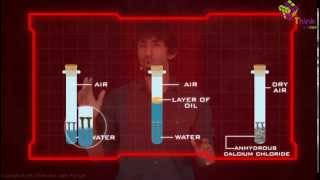What is Colloid?
A colloid is primarily a heterogeneous mixture in which the minute particles of one substance are dispersed in another substance, called the dispersion medium.
The minute particles here are 1 to 1000 nanometers in diameter but they still remain suspended and do not settle at the bottom of the mixture. They are visible under an optical or an electron (smaller particles) microscope.
Dispersed Phase and Dispersion Medium
A colloid is a mixture in which one substance which has fine particles (dispersed phase) mixed into another substance (dispersion medium). The particles of the colloids have a range from 1 to 1000 nm in diameter. The solution is called colloidal dispersion because the particles of solutions do not mix or settle down. They are dispersed in the solution.
The substances which are dispersed in the solution are called the dispersed phase, and the solution in which it is dispersed is called dispersion medium.
Recommended Videos

Types of Colloids
Colloids can be classified according to different properties of the dispersed phase and medium.
Firstly, based on the types of particles of the dispersed phase, colloids can be classified as:
- Multimolecular colloids
- Macromolecular colloids
- Associated colloids

1. Multimolecular Colloids
When the dissolution of smaller molecules of substance or many atoms takes place, they combine to form a species whose size is in the range of colloidal size. The species formed is known as the multimolecular colloids.
For example, the Sulphur solution contains particles which have thousands of S8.
2. Macromolecular Colloids
In this type of colloids, the macromolecules form a solution with a suitable solvent. The size of the particles of this macromolecular solution lies in the range of colloidal particles size. Thus, this solution is also known as the macromolecular colloids. The colloids formed here are similar to that of the actual solution in many respects and are very stable.
Example: Starch, proteins, enzymes, and cellulose are the naturally occurring macromolecular colloids whereas polyethene, synthetic rubber, etc. are the synthetic macromolecules.
3. Associated Colloids
Some substances act as a strong electrolyte when they are in low concentrations, but they react as colloidal sols when they are in high concentration. In higher concentration, particles aggregate showing colloidal behaviour. These aggregated particles are known as the micelles. They are also known as the associated colloids. The formation of the micelles occurs above a particular temperature called the Kraft temperature (Tk) and also above a specific concentration called the critical micelle concentration. These colloids can be reverted by diluting it. Examples of some associated colloids are soaps and synthetic detergents.
Examples of Colloids
Based on the physical state of the dispersion medium and of the dispersed phase, colloids can be classified into:
- Foam
- Solid Foam
- Aerosol
- Emulsion
- Gel
- Solid Aerosol
- Sols
- Solid sols
The following table describes the types along with examples:

Based on the nature of the interaction between the dispersion medium and the dispersed phase, colloids can be classified into lyophilic and lyophobic.
-
Lyophilic
If the dispersed phase has an affinity for the dispersion medium, the colloid is called a lyophilic colloid. The words lyo and philic means ‘liquid’ and ‘loving’ respectively. Thus, even if the dispersed phase is separated from the dispersion medium, they can readily be reconstituted by simply mixing them. Moreover, they are difficult to coagulate due to their stable nature. They are also known as intrinsic colloids. Examples are starch, rubber, protein, etc.
-
Lyophobic
If the dispersed phase has little or no affinity for the dispersion medium, the colloid is called a lyophobic colloid. The words lyo and phobic means ‘liquid’ and ‘fearing’ respectively. Hence, they are liquid-hating. They are difficult to prepare because the dispersed phase does not readily form a colloid with the dispersion medium, they require some special methods. They are unstable and require stabilizing agents for their preservation. They are also known as extrinsic colloids. Examples are sols of metals like silver and gold, sols of metallic hydroxides, etc.
After reading this article, we now know about the different types of colloids when classified from types of particles used in the dispersed phase. Learn more about the colloids, register with BYJU’S & download BYJU’S – The Learning App.




This is awesome and will like to know more